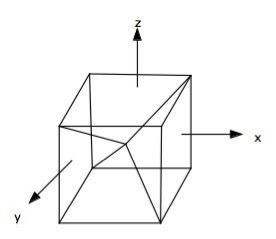 | ||
Tetrahedral (abbreviated Td) molecules are highly symmetric molecules that belong the Td symmetry group. In Td molecules, the dihedral bond angles between adjacent bonds is approximately 109.5°. Molecules within the Td point group include methane, phosphorus pentoxide, and adamantane. Molecular orbitals of Td molecules can be determined using reducible representations, SALCs and projection operator techniques.
Contents
Td Character Table
The tetrahedral symmetry group contains the symmetry operations of E, 8C3, 3C2, 6S4, and 6σd. In order to obtain the molecular orbitals of a Td molecule, a character table is used to find reducible representations, which are ultimately used to determine the bond types of the molecule. Each character table consists of its constituent irreducible representations denoted by their Mulliken symbols. The last two columns of the character table denotes the orbital analogous to the representation; for example, (x,y,z) represents px, py, and pz orbitals. Further descriptions of character tables can be found in this list of character tables for chemically important 3D point groups. The character table for the Td point group is the following:
Reducible Representation
Reducible representations (denoted as Γ) are useful tools in determining the molecular orbitals of a Td molecule. The reducible representation is a linear combination of irreducible representations found in the character table. Manipulation of reducible representations explain how many σ molecular orbitals and π molecular orbitals are found in the molecule. There are multiple methods utilizing reducible representations; two examples using methane are described below:
Method one
This method involves determining the reducible representations of the C-H bonds and the x, y, and z axes to determine the σ and π orbitals.
1. Considering C-H bonds (ΓCH)
With this reducible representation for C-H bond, the following equation can be used for each irreducible representation in order to determine whether it composes ΓCH:
ni=1/h∑NχRχI
In the above equation, ni is how many times the irreducible representation in question contributes to the Γ, h is the order of the group, N is the coefficient of each symmetry operation, χR is the character of the reducible representation, and χI is the character of the irreducible representation.
For this example, ΓCH= A1+T2. This reduced form shows that total four σ molecular orbitals are found by looking the identity (E) of A1 and T2. A1 has a basis of x2+y2+z2 which indicates that it has an s orbital (spherical) basis. T2 has a basis containing p(x,y,z) and d(xy,xz,yz).
2. Considering x, y, z axes (Γx,y,z)
3. ΓCH is multiplied by Γx,y,z (dot product), and can be expressed as Γσ+π = 12 0 0 0 2. Γσ (or ΓCH)= 4 1 0 0 2 is subtracted from Γσ+π to determine Γπ.
Γπ = 8 -1 0 0 0 and is reduced to E+T1+T2.
Method two
This method involves finding reducible representations of p-orbitals to determine σ and π orbitals.
Γp orbitals is determined, and provides Γπ. For methane, the results will be the same as in the previous method- Γπ= E+T1+T2. As a result, a total of eight π molecular orbital are found.
The reducible representation for methane provides Γ = 15 0 -1 -1 3. This representation equals A1+E+T1+3T2.
SALCs and MO diagram
SALCs, or Symmetry Adapted Linear Combination, are a useful technique for drawing molecular diagrams.
Methane will again be used for an example. Each hydrogen atom will be labelled number one through four.
Γσ = A1+T2 ; each symmetry operation from the character table is applied to the molecule, and the new position of the first hydrogen will be denoted. As A1 is a constituent of the reducible representation, each character of A1 is multiplied to the positions of that first hydrogen upon symmetry operation. For A1, this will yield (Φ1+Φ2+Φ3+Φ4). The figure of this SALC is shown on the right. T2 , which is triply degenerate, will yield (Φ1-Φ2-Φ3+Φ4), (Φ1-Φ2+Φ3-Φ4), and (Φ1+Φ2-Φ3-Φ4). In order to draw the diagram, find the number of the nodes to determine the energy level -the one with the least number of nodes would have the lowest energy. The energies for Td would be found a1(σ), t2(σ) < a1(σ) < t2(σ) < e(π) < t2(π) < t1(π). Note that the first a1(σ), t2(σ) is from the σ SALCs and the second is from the pσ SALCs. HOMO and LUMO could be found by drawing the diagram. The highest energy with orbital occupied is HOMO and the highest energy with orbital unoccupied is LUMO.
